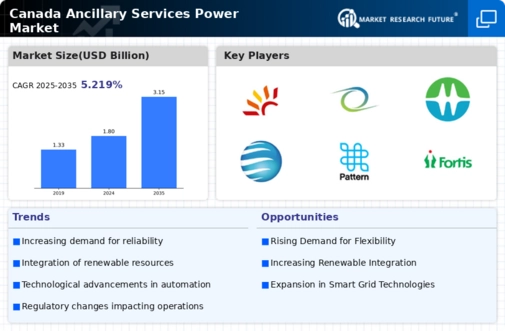Growing Demand for Grid Stability
The increasing complexity of the power grid in Canada necessitates enhanced grid stability, which is a primary driver for the ancillary services-power market. As more intermittent renewable energy sources are integrated, the need for ancillary services to maintain reliability becomes critical. In 2025, the demand for frequency regulation services is projected to rise by approximately 15%, reflecting the urgency for solutions that can balance supply and demand effectively. This growing demand indicates that the ancillary services-power market is likely to expand, as utilities and grid operators seek to ensure that the grid remains stable and resilient against fluctuations in energy supply.
Investment in Smart Grid Technologies
Investment in smart grid technologies is transforming the ancillary services-power market in Canada. These technologies facilitate real-time monitoring and management of electricity flows, enhancing the efficiency of ancillary services. In 2025, it is estimated that investments in smart grid infrastructure will exceed $2 billion, driving the need for advanced ancillary services to support these systems. The integration of smart meters and automated demand response programs allows for better load management, which is essential for maintaining grid reliability. Consequently, the ancillary services-power market is expected to benefit from these technological advancements, as they enable more responsive and flexible energy management solutions.
Rising Consumer Participation in Energy Markets
The trend of rising consumer participation in energy markets is reshaping the ancillary services-power market in Canada. With the advent of prosumers—consumers who also produce energy—there is a growing need for ancillary services that can accommodate decentralized energy generation. By 2025, it is projected that residential solar installations will increase by 25%, leading to a greater demand for services that can manage distributed energy resources. This shift indicates that the ancillary services-power market must evolve to support a more participatory energy landscape, where consumers play an active role in energy production and consumption.
Increased Regulatory Focus on Emission Reductions
The regulatory landscape in Canada is increasingly focused on reducing greenhouse gas emissions, which significantly impacts the ancillary services-power market. New regulations aimed at promoting cleaner energy sources are likely to drive demand for ancillary services that support the integration of low-emission technologies. By 2025, it is anticipated that compliance costs related to emissions could reach $1 billion, prompting utilities to invest in ancillary services that enhance the efficiency of their operations. This regulatory focus not only encourages the adoption of cleaner technologies but also creates opportunities for ancillary services that can help manage the transition to a more sustainable energy system.
Emergence of Electric Vehicles and Charging Infrastructure
The rapid adoption of electric vehicles (EVs) in Canada is emerging as a significant driver for the ancillary services-power market. As the number of EVs on the road increases, the demand for charging infrastructure and related ancillary services is expected to grow. By 2025, the number of public charging stations is projected to double, necessitating ancillary services that can manage the additional load on the grid. This surge in EV adoption not only creates opportunities for ancillary services to support charging needs but also highlights the importance of grid flexibility to accommodate the fluctuating demand associated with electric vehicle charging.


















Leave a Comment